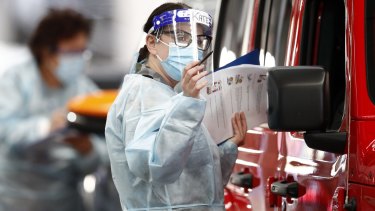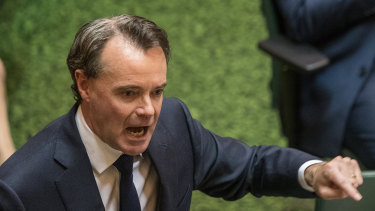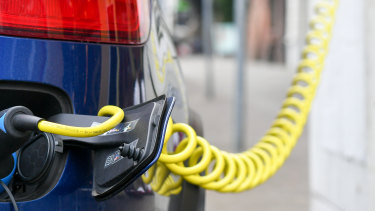Latest updates
We are having technical issues bringing you Tim Pallas' budget speech from State Parliament. We will try to stream it live as soon as possible.
In a budget where revenue is down and spending is up, the positive and negative impacts of the 2020 Victorian budget will be felt profoundly.
Here are the winners ...
Health
Frankston Hospital. Large chunks of work will start on the $562 million Frankston Hospital this year, with $16.2 million in this year's budget. There will be $27.2 million in the 2021/22 budget, $124.6 million in 2023/24 and $191 million in 2023/24.
Families in growth areas. Treasurer Tim Pallas has splashed $115 million for the Metropolitan Health Infrastructure Fund this year, and $66 million to acquire land in Cranbourne, Torquay, Pakenham, City of Whittlesea, Eltham, Point Cook and the inner south for community hospitals, as well as planning for three more.
Education
Students. A huge infrastructure spend of $3 billion in school upgrades will renew campuses and create jobs. There is almost $250 million for retired teachers to return to schools as tutors and $16.6 million to keep four-year-old kinder free next year.
Transport
Rail commuters. A total of $2.2 billion on the Suburban Rail Loop, $2 billion on Geelong fast rail, $660 million for the next stages of upgrades on the Shepparton and Warrnambool line. The government will also spend $276.5 million on the Dandenong corridor to allow for faster high-capacity metro trains to run and $5.5 million on track works around Caulfield station to enable the separation of the Frankston and Dandenong lines.
Tram users. A total of $1.48 billion will be spent on building 100 new modern accessible trams to retire the ageing A and Z-class trams. What will be the largest tram order in decades will include an order for new E-Class trams and possibly another variety, will also go towards a new maintenance facility in Melbourne’s north-west to support 1900 jobs.
Road users. A total of $1.6 billion in road network and infrastructure initiatives, including $2.5 million in the ‘Summer Streets’ program to provide traffic management during COVID safe outdoor events, $117 million package of road and intersection upgrades across Melbourne and $411 million to resurface, rebuild and maintain 1700 kilometres of roads.
Housing
Social housing residents. A total of 9300 new homes, including 2000 for those with a mental illness, have been announced. There will also be 2900 new affordable and low-cost homes for low-income earners so they can live closer to where they work. A quarter of this funding will go towards regional Victoria.
People at a high-risk of COVID-19. New funding to protect public housing residents from coronavirus, with the money to go towards testing, cleaning and security.
Small business/jobs
Job seekers. More than $620 million has been pledged towards a new program aimed at connecting people looking for work with a job that will suit them, including face-to-face support and mentors to help Victorians back into the work force.
Regional Victoria
Domestic tourists. Those wishing to visit regional Victoria will benefit from improved facilities at tourist hotspots like the Grampians, Wilsons Promontory and the state's ski fields. And the government will spend almost $30 million on vouchers to encourage intrastate holidaying.
Environment
Clean energy. In total $1.6 billion has been committed to clean energy, including $797 million last week for heating and cooling efficiency. New today is $540 million for six "renewable energy zones" in places such as sunny Mildura and the windy east coast.
The economy
Businesses. Businesses that hire new staff will be able to pay less in payroll taxes, and the threshold for paying payroll tax has increased.
New home buyers Up to 50 per cent of the stamp duty cost on homes valued up to $1 million will be waived.
Wondering how much will be spent on the coronavirus health response in this year's budget?
There are a number of initiatives designed to deal with the health and economic impacts of the pandemic and $2.9 billion in the 2020/21 budget for the public health team's response to COVID-19.
About half of that cost will be borne by the Commonwealth. The investment plunges over the forward estimates, with $37.6 million set aside in 2021/22, $6.1 million in 2022/23 and $6.3 million in 2023/24.

Coronavirus testing in Victoria.Credit:Getty
This year’s state budget is full of initiatives and projects aimed at getting Victoria to bounce back from the coronavirus pandemic, but to fuel this recovery the Andrews government has been forced to borrow big.
In real terms, net debt is expected to reach 154.8 billion in 2023/24. That’s about $23,000 for every Victorian resident.
This graph shows the state’s net debt levels over time as a blue line, with the projected increases in debt showing up as dotted lines. The green dotted line shows what the debt predictions were as of last year’s pre-COVID budget, while the red line shows the projections from this year’s COVID budget.
You will have noticed that in last year’s budget, long before summer’s bushfire crisis and the coronavirus pandemic, the amount of debt was projected to rise – although nowhere near as much as it is now projected to increase. This was to help pay for the North East Link, Melbourne Airport Rail and further level crossing removals.
As of June 30 this year, the state was $44.3 billion in debt. That’s about $5 billion more than the projections in last year’s state budget, with the difference partly being due to the COVID recovery measures that were put in place in recent months.
Treasurer Tim Pallas said the state was borrowing “to keep Victoria’s economy and livelihoods afloat”, adding the COVID-19 pandemic’s impact was “likely to be the biggest in nearly a century”.
Those are the real numbers, but a useful way to put the state’s growing debt pile in perspective is to express it as a percentage of the state’s economic output, the Gross State Product (GSP).
This helps to give a sense of the level of debt relative to the scale of the economy and also makes it easy to compare debt levels over time without having to add too many caveats about inflation.
Department of Treasury and Finance figures show that debt as a percentage is set to rise far above the levels of the early 90s recession, when net debt as a percentage of GSP maxed out at about 16 per cent.
Based on projections in the 2020/21 budget, net debt as a percentage of Gross State Product is set to reach 28.9 per cent in the 2023/24 financial year:
Pre-COVID, the Andrews government had promised to keep the state’s net debt at about 12 per cent of GSP over the next few years, reasoning that the cost of borrowing and favourable economic conditions made this level of debt manageable for it to pursue its ambitious infrastructure program.
Here is a snap look at Victoria's finances from our state political editor Noel Towell ...
Today's budget papers show the full horror of what the pandemic has done to Victoria's finances.
Government revenues have been smashed with Treasury expecting to get just under $67.7 billion this financial year, nearly $8 billion down from the $74.4 billion it forecast pre-pandemic.
The impact extends to all of the government's big earning revenue lines. Stamp duty decreased from an expected $6.25 billion to just $4.55 billion. Payroll tax was down to $5.4 billion from nearly $7 billion forecast last year.
The tax collected on poker machine revenue chopped in half, more or less, from $1.1 billion to $611 million, as pubs and clubs were forced to shut their doors for long periods of the year.
Crown Casino taxes are just a third of what was expected, at just $78 million.
And the state government's biggest earner, Commonwealth grants including the state's slice of the national GST pie, was down nearly $1.5 billion, a first taste of what Treasurer Tim Pallas says will be a $12 billion write-down over the next four years.
Here we go ... the budget embargo has lifted, Treasurer Tim Pallas is about to speak in Parliament, and our reporters are free from the lock-up.
We will bring you the latest figures from the budget papers, fresh analysis and all the afternoon's developments so do stay with us.
Over recent weeks, Opposition Leader Michael O’Brien has accused Labor of planning to borrow "eye-watering" sums of money to fund budget blowouts and waste.
"The trouble with this amount of borrowing is that Labor’s track record is that they don’t borrow to build, they borrow to waste, they borrow for budget blowouts and that’s what Victorian can’t afford," the Liberal leader said over the weekend.

Liberal Opposition Leader Michael O'Brien.Credit:Jason South
"Under these figures, Victorians will see an extra $20,000 in debt for every man, woman and child in this state."
Shadow treasurer Louise Staley made her comments via Twitter last week:
Let's revisit one of the government's key pre-budget announcements – the electric car tax.
Victoria will start taxing electric vehicle owners next year for every kilometre they drive in a budget initiative the state Labor government says will make road charging "fairer" for all motorists, state political reporter Noel Towell revealed last week.

Victoria will start taxing electric vehicle owners next year for every kilometre they drive.
But Treasurer Tim Pallas said the $30 million expected to be raised by the new charge, over four years, will be more than offset by $45 million spending to boost the take-up of electric vehicles, with charging points across the state and plug-in facilities in new buildings.
The government’s new electric vehicle charge will levy 2.5 cents per kilometre driven by electric and other low emissions vehicles and 2 cents for plug-in hybrid electric models.
Mr Pallas said on Saturday he expected the charge to raise about $30 million, with the average motorist paying a "modest charge" of between $260 and $300 a year.
“When you consider that people who drive internal combustion engines, either petrol or diesel, those people are paying every day fuel excise,” the Treasurer said.
"If you’re not filling your vehicle up with petrol, then ultimately you’re not paying your share of maintenance costs of dealing with our road system, so this is essentially the government making it a fairer system that so that everybody pays their fair share of that wear and tear."
The revenue raised from the new charge will not be put back into electric vehicle infrastructure like charging points, Mr Pallas said, but Tuesday’s budget would allocate more than $45 million to pay for policies that boost the take-up of low emission and no-emission vehicles.
"We will more than offset the revenue that we get, so we will be expending more to make sure that we have appropriate charging locations for electric vehicles right across the state and we’ll also put in place arrangements to make sure our planning and our new buildings are all ready for plug-in electric vehicles," Mr Pallas said.
As we wait for our state political reporters to be freed from the lock-up and Treasurer Tim Pallas to walk up to State Parliament, here's an image of what the new Melton Hospital in Melbourne's west could look like.
The government has already announced there will be $75 million in this year's budget for design, early planning works and land acquisition for the new hospital in Melbourne's growing north-western suburbs.
The hospital investment, which the government has been pressured to build for years, will come alongside about $320 million for refurbishing metropolitan and rural health facilities.
https://news.google.com/__i/rss/rd/articles/CBMiqQFodHRwczovL3d3dy50aGVhZ2UuY29tLmF1L3BvbGl0aWNzL3ZpY3RvcmlhL3ZpY3Rvcmlhbi1idWRnZXQtbGl2ZS11cGRhdGVzLXRpbS1wYWxsYXMtdG8tc3BlYXJoZWFkLXN0YXRlLXMtY292aWQtMTktcmVjb3ZlcnktYW1pZC1yZWNvcmQtZGVidC1kZWZpY2l0LTIwMjAxMTI0LXA1Nmhjdi5odG1s0gGpAWh0dHBzOi8vYW1wLnRoZWFnZS5jb20uYXUvcG9saXRpY3MvdmljdG9yaWEvdmljdG9yaWFuLWJ1ZGdldC1saXZlLXVwZGF0ZXMtdGltLXBhbGxhcy10by1zcGVhcmhlYWQtc3RhdGUtcy1jb3ZpZC0xOS1yZWNvdmVyeS1hbWlkLXJlY29yZC1kZWJ0LWRlZmljaXQtMjAyMDExMjQtcDU2aGN2Lmh0bWw?oc=5
2020-11-24 02:15:00Z
CBMiqQFodHRwczovL3d3dy50aGVhZ2UuY29tLmF1L3BvbGl0aWNzL3ZpY3RvcmlhL3ZpY3Rvcmlhbi1idWRnZXQtbGl2ZS11cGRhdGVzLXRpbS1wYWxsYXMtdG8tc3BlYXJoZWFkLXN0YXRlLXMtY292aWQtMTktcmVjb3ZlcnktYW1pZC1yZWNvcmQtZGVidC1kZWZpY2l0LTIwMjAxMTI0LXA1Nmhjdi5odG1s0gGpAWh0dHBzOi8vYW1wLnRoZWFnZS5jb20uYXUvcG9saXRpY3MvdmljdG9yaWEvdmljdG9yaWFuLWJ1ZGdldC1saXZlLXVwZGF0ZXMtdGltLXBhbGxhcy10by1zcGVhcmhlYWQtc3RhdGUtcy1jb3ZpZC0xOS1yZWNvdmVyeS1hbWlkLXJlY29yZC1kZWJ0LWRlZmljaXQtMjAyMDExMjQtcDU2aGN2Lmh0bWw
Bagikan Berita Ini














0 Response to "Victorian budget LIVE updates: Tim Pallas to spearhead state's COVID-19 recovery amid record debt, deficit - The Age"
Post a Comment